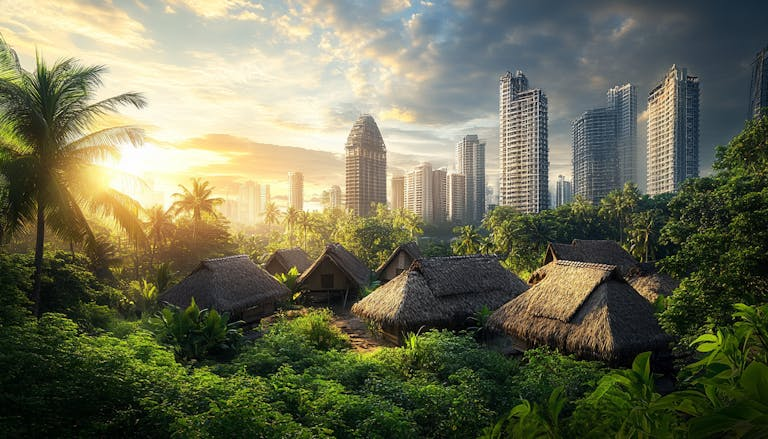
The real estate landscape in the Philippines has undergone significant transformations over the centuries, shaped by historical events, economic shifts, and social changes. Understanding this evolution provides insight into the sector’s current trends and future directions.

Here are simplified historical facts about real estate in the Philippines:
- Spanish Colonial Period: Land was mainly owned by Spanish elites and the Catholic Church, leading to a feudal system.
- Land Reform: The 1988 Agrarian Reform Law aimed to redistribute land to farmers and tenants, changing ownership patterns.
- Post-War Housing: After World War II, there was a housing shortage, prompting new residential developments and subdivisions.
- Economic Reforms: The 1980s opened the market to foreign investments, boosting commercial and residential property development.
- BPO Boom: The rise of the BPO industry in the 2000s increased demand for office spaces and condos, especially in Metro Manila.
- Condominium Growth: The late 1990s and early 2000s saw a surge in condominiums due to urbanization and the needs of young professionals.
- Sustainability Focus: Recent years have prioritized sustainable development, emphasizing disaster-resilient and eco-friendly construction.
- Smart City Initiatives: The government is promoting smart city concepts to improve urban living through technology and planning.
These points highlight the dynamic evolution of real estate in the Philippines, shaped by various cultural, economic, and environmental influences.
Spanish Colonial Period
During the Spanish colonial period (1565-1898), land ownership was concentrated among Spanish elites and the Catholic Church. This feudal system created a stark divide between landowners and farmers, with most Filipinos working as tenants on lands they did not own. The structure of land ownership during this time laid the groundwork for future conflicts and reforms regarding land distribution.
Land Reform Initiatives
In response to long-standing issues related to land ownership, the Philippine government implemented the 1988 Agrarian Reform Law. This landmark legislation aimed to redistribute agricultural lands from large estates to farmers and tenants, fundamentally altering property ownership patterns across rural areas. Although challenges remain in fully realizing its goals, this reform marked a significant step toward equitable land distribution.
Post-War Housing Developments
The aftermath of World War II brought about an acute housing shortage as many displaced families sought shelter. This crisis spurred new residential developments and subdivisions across urban areas, particularly in Metro Manila. The need for affordable housing led to innovative construction methods and planning strategies that addressed both quantity and quality.
Economic Reforms and Foreign Investment
The economic landscape shifted dramatically in the 1980s when the Philippines opened its market to foreign investments. This liberalization fueled commercial and residential property development, leading to increased competition and diversification within the real estate sector. Developers began exploring various projects catering to both local needs and international investors.
The BPO Boom
The rise of the Business Process Outsourcing (BPO) industry in the 2000s significantly impacted real estate demand. As multinational companies established operations in Metro Manila, there was a surge in demand for office spaces tailored to BPO requirements. Concurrently, this growth also spurred interest in condominiums as more professionals sought convenient living arrangements close to their workplaces.
Condominium Growth Surge
From the late 1990s through the early 2000s, urbanization accelerated rapidly due to migration patterns favoring metropolitan areas like Manila. Young professionals increasingly favored condominium living for its accessibility and amenities. This trend led developers to invest heavily in high-rise buildings that catered specifically to this demographic’s lifestyle preferences.
Emphasis on Sustainability
In recent years, sustainability has become a focal point within Philippine real estate development. Stakeholders are increasingly prioritizing eco-friendly practices and disaster-resilient structures amidst growing environmental concerns. New regulations encourage green building certifications while promoting sustainable community designs harmonizing with natural landscapes.
Smart City Initiatives
As part of ongoing efforts to enhance urban living conditions, government initiatives have embraced smart city concepts to integrate technology into urban planning. These initiatives focus on improving infrastructure efficiency, enhancing public services through digital solutions, and fostering sustainable growth patterns that can accommodate increasing populations without compromising quality of life.
Conclusion
The historical trajectory of real estate in the Philippines reflects broader socio-economic trends influenced by colonial legacies, legislative reforms, economic opportunities, technological advancements, and environmental considerations. As these dynamics continue evolving, they shape not only how properties are developed but also how communities interact with their environments—ultimately defining what it means to live sustainably within an ever-changing urban landscape.
